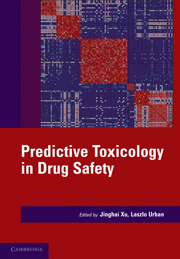Book contents
- Frontmatter
- Contents
- Contributors
- Prologue – Predictive toxicology: a new chapter in drug safety evaluation
- PREDICTIVE TOXICOLOGY IN DRUG SAFETY
- I SPECIFIC AREAS OF PREDICTIVE TOXICOLOGY
- II INTEGRATED APPROACHES OF PREDICTIVE TOXICOLOGY
- 10 Integrated approaches to lead optimization: improving the therapeutic index
- 11 Predictive toxicology approaches for small molecule oncology drugs
- 12 Mechanism-based toxicity studies for drug development
- 13 Fish embryos as alternative models for drug safety evaluation
- 14 The role of genetically modified mouse models in predictive toxicology
- 15 Toxicogenomic and pathway analysis
- 16 Drug safety biomarkers
- 17 Application of TK/PD modeling in predicting dose-limiting toxicity
- 18 Prediction of therapeutic index of antibody-based therapeutics: mathematical modeling approaches
- 19 Vaccine toxicology: nonclinical predictive strategies
- Epilogue
- Index
- Plate section
- References
10 - Integrated approaches to lead optimization: improving the therapeutic index
from II - INTEGRATED APPROACHES OF PREDICTIVE TOXICOLOGY
Published online by Cambridge University Press: 06 December 2010
- Frontmatter
- Contents
- Contributors
- Prologue – Predictive toxicology: a new chapter in drug safety evaluation
- PREDICTIVE TOXICOLOGY IN DRUG SAFETY
- I SPECIFIC AREAS OF PREDICTIVE TOXICOLOGY
- II INTEGRATED APPROACHES OF PREDICTIVE TOXICOLOGY
- 10 Integrated approaches to lead optimization: improving the therapeutic index
- 11 Predictive toxicology approaches for small molecule oncology drugs
- 12 Mechanism-based toxicity studies for drug development
- 13 Fish embryos as alternative models for drug safety evaluation
- 14 The role of genetically modified mouse models in predictive toxicology
- 15 Toxicogenomic and pathway analysis
- 16 Drug safety biomarkers
- 17 Application of TK/PD modeling in predicting dose-limiting toxicity
- 18 Prediction of therapeutic index of antibody-based therapeutics: mathematical modeling approaches
- 19 Vaccine toxicology: nonclinical predictive strategies
- Epilogue
- Index
- Plate section
- References
Summary
INTRODUCTION: RISK AWARENESS, A MAJOR ELEMENT OF MODERN DRUG DISCOVERY
Since the introduction of simple, in silico, and in vitro tools for the assessment of physicochemical properties in the 1990s. drug discovery has come a long way. The impact of these tools was based on their acceptable predictive value for in vivo pharmacokinetic performance and their cost effectiveness for large-scale profiling. During the past decade, we have seen a rapid improvement in the throughput and quality of these assays, accompanied by an impressive development of in silico tools based on accumulating experimental knowledge. Today, most if not all, pharmaceutical companies use an arsenal of these assays to fine-tune compound properties prior to clinical testing. This “revolution” has resulted in diminished attrition rate due to ADME-related liabilities.
The significant improvement in ADME (absorption-distribution-metabolism-elimination) properties in the early phases of drug discovery indeed shifted the challenges in lead optimization and candidate selection toward safety and toxicology aspects. This is partly due to the complexity of safety assessment, which is difficult to translate into high-throughput, cost-effective in vitro assays with significant predictive value and partly due to the mandatory use of fixed assays required by regulatory authorities. In addition, some toxicities such as reactive metabolite-related hepatotoxicity remain difficult to predict in vitro. To date, most safety-related assays have been performed in vivo with limited insight into the underlying mechanisms that would define the link between a particular target molecule and the observed toxic or adverse drug reaction (ADR).
- Type
- Chapter
- Information
- Predictive Toxicology in Drug Safety , pp. 183 - 203Publisher: Cambridge University PressPrint publication year: 2010



